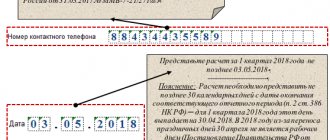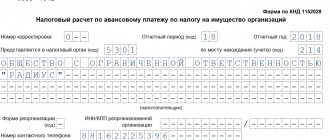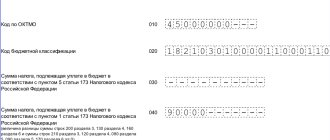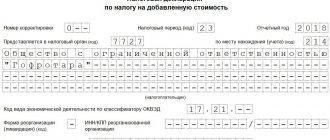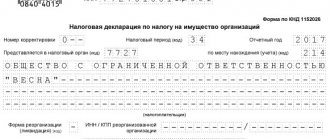Objects of tax assessment
Enterprises provide the fiscal service with reporting for objects drawn up according to a unified template. Line 210 of the property tax return specifies the base tax amount for calculations. Legal entities, on the basis of the Tax Code, transfer property duties in the following cases:
- presence of real estate on the balance sheet, which is the main resource;
- residential real estate not registered in the accounting records of the owner;
- ownership of movable objects by OSNO organizations since 2013, regardless of the fact of reorganization, liquidation, or receipt from subsidiaries.
The 2018 property tax declaration does not include movable objects that have been in use for 1 to 3 years. The basis for exemption from contributions is Art. 374 NK.
Details about corporate property tax in 2021
Who pays the tax
According to current legislation, tax is required to be paid by:
- organizations on the general taxation system (GTS) - owners of real estate;
- business entities in the “imputed” and “simplified” areas that own areas used for the placement of retail and office premises, if the need to pay tax follows from the provisions of the legislation of the constituent entity of the Russian Federation;
- firms and individual entrepreneurs paying the unified agricultural tax (UST) in relation to property not used for the production, processing and sale of agricultural products;
- foreign companies that do not have permanent representative offices in the Russian Federation.
The tax is paid to the state budget quarterly. It is transferred to the Federal Tax Service at the location:
- organizations;
- a separate division with a separate balance sheet;
- property for which tax is paid.
Changes in property tax declaration for 2021
The new property tax declaration 2018 was put into effect on the basis of Federal Tax Service Order No. ММВ-7-21/271. The document has undergone a number of adjustments:
- OKVED codes are not written down and stamps are not affixed;
- KZD is indicated - preferential contributions for the railway industry;
- property codes are recorded, the tax on which is paid at a preferential rate;
- section 2.1 is completed with a detailed indication of real estate and taxes on it for each branch of the enterprise.
According to the updates of paragraphs 24-25 of Art. 381 of the Tax Code, regional authorities are given the right to adopt laws on benefits for legal entities. For administrative, business, and trade objects, taxation is calculated on the basis of the cadastral valuation of the objects.
Rules for filling out the report
The rules for filling out a property tax return are given in the Order of the Federal Tax Service MMV-7-21/, effective from 2021. Tax authorities indicate the following general requirements:
- The document contains data for one year.
- All amounts are rounded to full rubles according to the rules of mathematics.
- Each page of the report is numbered in the format “001”, “002”, etc.
- The declaration lines are filled in from left to right, cells that become empty are crossed out.
- On each page of the document, the TIN and KPP of the legal entity are written at the top.
If the reporting form is submitted on paper, it is not allowed to print on both sides of one sheet, staple the pages, or correct errors with a proofreader. The fields of the declaration must be filled out on the computer or by hand in printed capital letters.
Composition of the new tax return
For legal entities, 2021 means a transition to a new duty payment system. After the amendment to the Tax Code of the Russian Federation in Art. 380 a rate of 2.2% is prescribed, and the property tax declaration includes:
- title page - information about the duty-paying company (TIN, KPP, correction number, codes) and the employee who submitted the report is indicated;
- 1st section with the cost of tax payments on real estate and movable objects;
- 2nd section with the definition of the tax base;
- section 2.1. with a detailed list of real estate subject to an average annual duty;
- 3rd section with the amount of tax based on the cadastral assessed value of real estate.
The cadastral value of objects is as close as possible to the market balance, which increases the tax percentage.
Filling out a property tax return
In empty fields of the report, dashes are inserted. When entering data manually, the use of multi-colored ink is not allowed; all cost indicators are given in full rubles without kopecks. The header of the report contains the INN and KPP numbers of the enterprise, which are duplicated on each page; a mandatory element is continuous numbering of the sheets. All text lines must be filled in capital block letters.
Title page
What information should be reflected on the title page:
- correction number (if the report is primary, then “0”);
- code designation of the tax period (34 – annual interval, 50 – reporting period of the reorganized structure);
- reporting year;
- code of the Federal Tax Service department to which the document is submitted;
- code by place of registration (213 – the largest taxpayers, code 215 is used by successors with the status of the largest taxpayer, 216 – by successors from among the largest taxpayers, 214 – by ordinary legal entities, etc.);
- Company name;
- for reorganized companies, the form of reorganization and company registration codes are indicated;
- contact details, number of sheets in the report and attachments;
- who submits the report - the taxpayer (manager) or his representative (in this case, the details of the power of attorney must also be entered).
Section 2
At the next stage, Section 2 is drawn up. There may be several such sheets, for example, if the calculation is filled out separately for property taxed at the location of the company and for assets located outside the location (clause 5.2 of the Filling Out Procedure).
The page header (line 001) indicates the property type code (the list of codes is given in Appendix No. 5 to the Filling Out Procedure). On line 010, enter the OKTMO code linked to the place of tax payment. Lines 020-140 indicate the amount of the residual value of taxable property as of the beginning of each month of the year and as of December 31 of the reporting year, the value of preferential assets is separately highlighted.
Calculations begin with line 150 - it provides data on the average annual value of property (the sum of the indicators on lines 020-140 is divided by 13). If an enterprise has property tax benefits, they are indicated by codes in line 160 (codes in Appendix No. 6 to the Filling Out Procedure).
In field 170 the average annual value of non-taxable property is highlighted. Line 180 is not filled in by all taxpayers, but only by those who indicated property type code 02 in line 001.
Line 190 records the estimated tax base. It is displayed according to the following scheme:
- the difference between the average annual value of assets subject to taxation and those exempt from tax is determined (line 150 value – line 170 indicator);
- the result of the previous calculations is multiplied with the value of column 180 (if it is filled in, if there is a dash in it, the difference in costs from the previous step is taken as a basis).
Line 210 of the property tax return reflects the tax rate in force in the region for the corresponding type of property. If the enterprise has benefits in relation to the asset in question, expressed in a reduction in the rate, a reduced value is entered in line 210, on which calculations must be made. Line 215 is filled in only for railway tracks (Kzh coefficient). The rules for determining KZD are fixed in paragraph 2 of Art. 385 Tax Code of the Russian Federation.
Line 220 displays the amount of tax liability for the year:
- the tax base (column 190) is multiplied with the tax rate (page 210 of the property tax declaration) and the Kzh coefficient (if it is indicated in column 215);
- the result obtained is divided by 100.
For example, if column 190 indicates the amount of 1,963,577 rubles, and line 210 indicates a rate of 2.2%, then the tax amount in line 220 will be 43,199 rubles. (1963577 x 2.2 / 100).
Line 230 of the property tax return reflects the amount of accrued advance payments.
The values reflected in columns 240-260 are aimed at adjusting the tax liability downward due to benefits and tax payments made outside the Russian Federation.
Line 270 of the property tax return is intended to record the level of residual value of taxable fixed assets as of the end of the reporting year.
Section 2.1
Section 2.1 indicates the data of all objects taxed at the average annual value (it is based on them that the tax amount in section 2 is formed):
- on pages 010, 020 - cadastral or conditional number of the object according to the Unified State Register of Real Estate (if available);
- the inventory number of the object on page 030 (its reflection is necessary in the only case - if the asset has neither a cadastral nor a conditional number);
- OKOF code on page 040 (indicated in accordance with the “All-Russian Classifier of Fixed Assets”);
- the amount of the residual value of assets as of December 31 of the reporting year (line 050).
Section 3
Section 3 records data on objects from which tax is levied at cadastral value.
The cadastral numbers of the property are given (separate codes for buildings and premises), the size of the cadastral valuation and the amount of the share in ownership, and benefits are indicated (lines 014-050). Based on these parameters, line 060 displays the tax base for the object.
Column 080 indicates the tax rate as a percentage. Next, enter the calculated tax amount in line 100, and advance payments accrued during the year in column 110.
Section 1
The final stage is filling out section 1. It indicates the OKTMO and KBK codes by which the tax is paid.
Line 030 records the calculated amount of tax liabilities for the year minus advance payments. In our example, the tax payable is 9812 rubles. (43199 – 33387).
Line 040 displays the amount that reduces tax liabilities if, as a result of calculating the tax payable, a negative result is obtained. Such indicators should be indicated in section 1, summarized by the corresponding OKTMO and KBK codes.
How to fill out the 2018 sample form?
The procedure for filling out a property tax return in 2021 is regulated by law and provides for:
- indication of the cadastral number of the object in line 010;
- bringing the conditional number from UGRN in line 020, if the cadastral number is missing;
- bringing the inventory number in line 030 or the OKOF code in line 040, if there is no fact of registration of rights to the object.
After submitting the document, the taxpayer receives a notification for payment. In its absence, the amount of payments is specified on the Federal Tax Service website. A registered user, based on the base - cadastral, inventory assessment and reduction factor, can calculate the amount of duty using the formula H = (KO-IO)*PC+IO. If a legal entity is preparing a property tax return for the first time, a sample form can be downloaded below:
Property tax return 2021 - sample form
Deadlines for sending tax reports
Deadlines for submitting property tax returns for legal entities are established regionally in accordance with clause 1 of Art. 383, art. 385 Tax Code. Regulatory documents of individual regions mark the periods until March 30, until April 10, until April 15 for the past year, 10 days after the submission of previous reports. You can check the time of data transfer and the date of payments at the regional tax office.
Declaration of taxes on movable and immovable property according to the new model provides for independent calculation of the duty. Benefits for enterprises are the responsibility of local authorities.
Similar articles
- Declaration of corporate property tax 2018
- Property tax declaration
- Organizational property tax
- Procedure for filling out a property tax return
- Property tax benefit - code 2010257
Due date and liability for lateness
The report is submitted once a year.
In accordance with the requirements of Article 386 of the Tax Code of the Russian Federation, send it to the territorial body of the Federal Tax Service before March 30 of the year following the reporting year. If the date falls on a weekend or holiday, the deadline for delivery is moved to the next working day. In 2021, March 30 is a Saturday, which means the deadline is postponed to April 1. If an organization is late in submitting its declaration, it may be fined under Article 119 of the Tax Code of the Russian Federation. Officials may be held administratively liable under Article 15.5 of the Code of Administrative Offenses of the Russian Federation.
